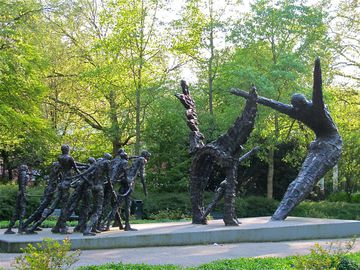

This large municipal park borders the Oost (East), arguably Amsterdam's most ethnically and culturally diverse neighborhood. Many immigrants from Surinam, Turkey, Morocco and Indonesia, as well as more recently from Eastern and Southern Europe, have historically settled in this part of town. In homage to this, every summer, Oosterpark hosts several ethnic music and dance festivals.
Oosterpark was the first large-scale public park created by the municipality in Amsterdam. It was designed in 1891 by Leonard Antonij Springer, the son of a renowned realist painter and one of the foremost landscape architects in the country at the time. In order to construct such a sizable park, the municipality had to remove a cemetery and demolish several small estates. Springer, a prolific park and garden designer who has left a legacy of close to 900 different landscaping projects, drafted plans for a the park centered around an elongated lake, which was typical of English landscaping style and that dominates Dutch landscape architecture style to this day.
Wandering around Oosterpark, a visitor may encounter several monuments and numerous sculptures. One example is the National Monument to the Abolition of Slavery which commemorates the official abolition in 1861 and which was created by Erwin Jules de Vries, a sculptor originally from the former Dutch colony of Surinam. One other large-scale monument is a 4,5-meter tall modern sculpture by the artist Jeroen Henneman entitled The Scream, which happens to be a memorial to Theo van Gogh, who is a distant relative of the world-famous post-Impressionist painter and was a filmmaker, murdered in 2004 by a religious extremist within a stone's throw from the park. According to its creator, the statue of Theo van Gogh shows him as screaming for mercy.
Another artwork is a somewhat smaller Flame – an abstract form made from stainless steel pipes - by the contemporary artist and writer Jan Wolkers. This sculpture commemorates the Dutch literature movement called De Tachtigers. A sympathetic small bronze statue by the artist Hans Bayens depicting three men sitting on the bench is entitled Titaantjes and is a monument to Nescio, a well-known Amsterdam author, and his colleagues. Several other artworks in the park include the bronze Goat Rider by Gerrit Boluis, Playing Children by Kattinka van Rood, and an ornamented white stone bench by the artist Eduard Jacobs, which commemorates another author - Justus van Maurik.
In 2005 a stone marker dedicated to free speech was placed to indicate an area where debates and speeches can be held, similar in manner to the Hyde Park corner in London. In addition to the above, several other sculptures can make a visit to the park take up the better portion of a day.
Among the birds one can observe at the Oosterpark the most prominent are grey herons, but visitors can also often spot exotic green parrots, who – after running away from their owners and forming their own colonies have grown accustomed to the colder Western European climate. Wild ducks can be observed swimming in the park's ponds and many other birds have built nests in the trees around park.
The park is well kept and clean; its trees provide shadow while the wide, open spaces are good for a picnic, exercise or relaxation. Two public tennis courts and a children’s playground are open year-round. At the north-western corner of the park, the visitor will encounter Hotel Arena: the former nursing home turned into a night club, hotel and restaurant complex that hosts many events.